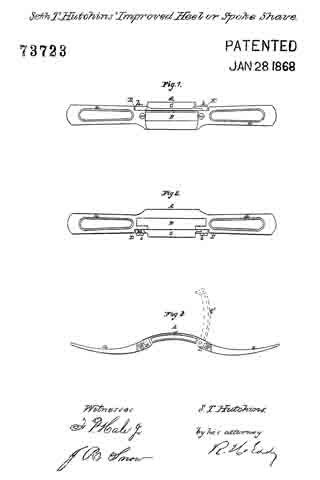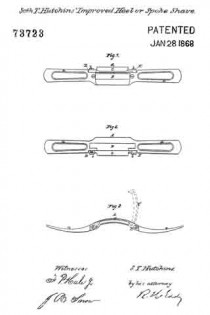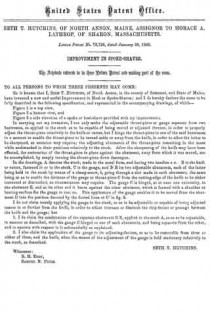
| PLEASE NOTE: The images presented on this page are of low resolution and, as a result, will not print out very well. If you wish to have higher resolution files then you may purchase them for only $2.95 per patent by using the "Buy Now" button below. All purchases are via PayPal. These files have all been cleaned up and digitally enhanced and are therefore suitable for printing, publication or framing. Each zip package contains all the images below (some packages may contain more), and purchased files can be downloaded immediately. |
United States Patent Office.
SETH T. HUTCHINS, OF NORTH ANSON, MAINE, ASSIGNOR TO HORACE A.
LATHROP, OF SHARON, MASSACHUSETTS.
Letters Patent No. 73,723, dated January 28, 1868.
_________________
IMPROVEMENT IN SPOKE-SHAVES.
_________________
The Schedule referred to in these Letters Patent and making part of the same.
_________________
TO ALL PERSONS TO WHOM THESE PRESENTS MAY COME:
Be it known that I, SETH T. HUTCHINS, of North Anson, in the county of Somerset, and State of Maine, have invented a new and useful Improvement in Heel or Spoke-Shaves; and I do hereby declare the same to be fully described in the following specification, and represented in the accompanying drawings, of which —
Figure 1 is a. top view,
Figure 2 a bottom view, and
Figure 3 a side elevation of a spoke or heel-shave provided with my improvement.
In carrying out my invention, I not only make the adjustable throat-piece or gauge separate from two buttresses, so applied to the stock as to be capable of being moved or adjusted thereon, in order to properly adjust the throat-piece relatively to the knife or cutter, but I hinge the throat-piece to one of the said buttresses in a manner to enable the throat-piece to be turned aside or away from the knife, in order to allow the latter to be sharpened, as occasion may require; the adjusting abutments of the throat-piece remaining in the mean while undisturbed in their positions relatively to the stock. After the sharpening of the knife may have been effected, the restoration of the throat-piece to place against the abutment, away from which it was moved, can be accomplished, by simply turning the throat-piece down thereupon.
In the drawings, A denotes the stock, made in the usual form, and having two handles a a. B is the knife or cutter, fastened in or to the stock, C is the gauge, and D E its two adjustable abutments, each of the latter being held to the stock by means of a clamp-screw, b, going through a slot made in such abutment; the same being so as to enable the distance of the gauge or throat-piece C from the cutting-edge ofthe knife to be either increased or diminished, as circumstances may require. The gauge C is hinged, at or near one extremity, to the abutment E, and at its other end it bears against the other abutment, which is formed with a shoulder or bearing-surface for the gauge to rest on. This application of the gauge enables it to be moved from the abutment D into the position denoted by the dotted lines at G’ in fig. 3.
I do not claim merely applying the gauge to the stock, so as to be adjustable or capable of being adjusted nearer to or further from the knife, in order to either increase or diminish the chip-throat or passage between the knife and the gauge; but
1. I do claim the combination of the separate abutments D E, applied to the stock A, so as to be adjustable, in manner as described, with the gauge C hinged to one of such abutments, and being separate from the other, and to operate with respect to it substantially as explained.
2. I also claim the application of the gauge to its adjusting-devices, so as to be removable from them or either of them, and the knife, when the means of the adjustment of the gauge is held stationary relatively to the stock, as described.
SETH T. HUTCHINS.
Witnesses :
R. H. EDDY,
SAMUEL N. PIPER.


